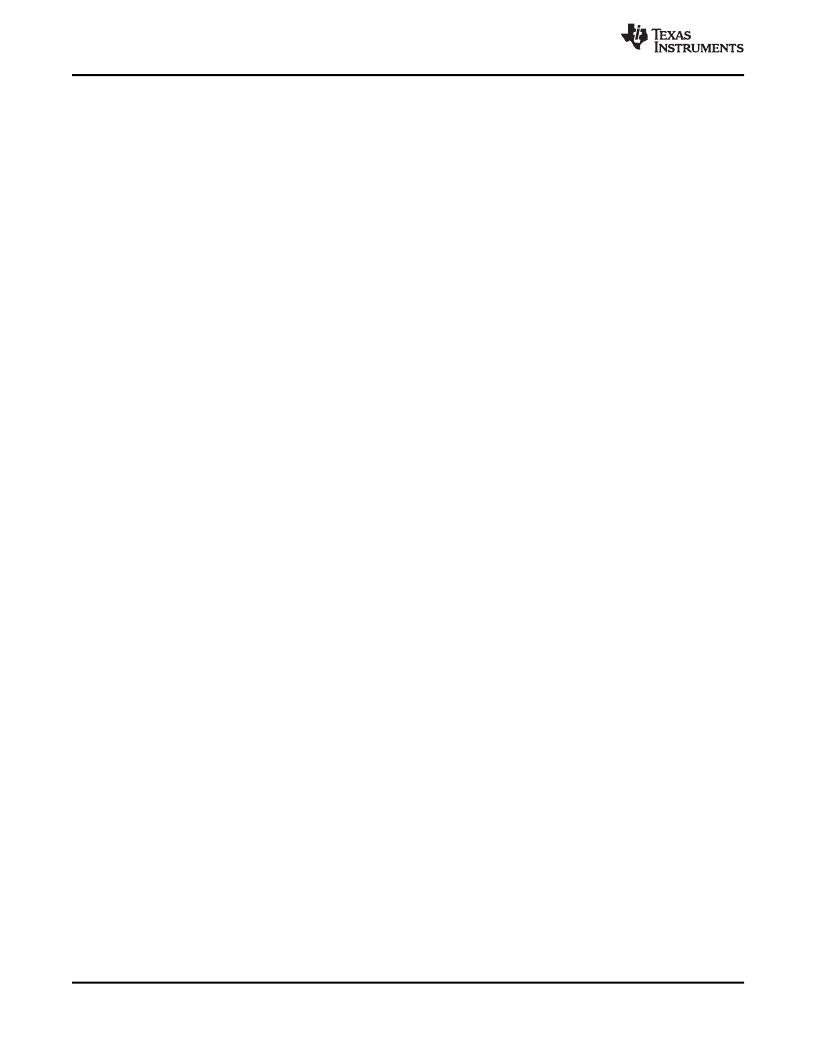- 您现在的位置:买卖IC网 > Sheet目录528 > TRF7970AEVM (Texas Instruments)EVAL MODULE FOR TRF7970A
�� �
�
 �
�TRF7970A�
�SLOS743K� –� AUGUST� 2011� –� REVISED� APRIL� 2014�
�www.ti.com�
�6.4�
�6.4.1�
�6.4.2�
�Receiver� –� Analog� Section�
�Main� and� Auxiliary� Receivers�
�The� TRF7970A� has� two� receiver� inputs:� RX_IN1� (pin� 8)� and� RX_IN2� (pin� 9).� Each� of� the� input� is�
�connected� to� an� external� capacitive� voltage� divider� to� ensure� that� the� modulated� signal� from� the� tag� is�
�available� on� at� least� one� of� the� two� inputs.� This� architecture� eliminates� any� possible� communication� holes�
�that� may� occur� from� the� tag� to� the� reader.�
�The� two� RX� inputs� (RX_IN1� and� RX_IN2)� are� multiplexed� into� two� receivers� -� the� main� receiver� and� the�
�auxiliary� receiver.� Only� the� main� receiver� is� used� for� reception,� the� auxiliary� receiver� is� used� for� signal�
�quality� monitoring.� Receiver� input� multiplexing� is� controlled� by� bit� B3� in� the� Chip� Status� Control� register�
�(address� 0x00).�
�After� startup,� RX_IN1� is� multiplexed� to� the� main� receiver� which� is� composed� of� an� RF� envelope� detection,�
�first� gain� and� band-pass� filtering� stage,� second� gain� and� filtering� stage� with� AGC.� Only� the� main� receiver�
�is� connected� to� the� digitizing� stage� which� output� is� connected� to� the� digital� processing� block.� The� main�
�receiver� also� has� an� RSSI� measuring� stage,� which� measures� the� strength� of� the� demodulated� signal�
�(subcarrier� signal).�
�The� primary� function� of� the� auxiliary� receiver� is� to� monitor� the� RX� signal� quality� by� measuring� the� RSSI� of�
�the� demodulated� subcarrier� signal� (internal� RSSI).� After� startup,� RX_IN2� is� multiplexed� to� the� auxiliary�
�receiver.� The� auxiliary� receiver� has� an� RF� envelope� detection� stage,� first� gain� and� filtering� with� AGC� stage�
�and� finally� the� auxiliary� RSSI� block.�
�The� default� MUX� setting� is� RX_IN1� connected� to� the� main� receiver� and� RX_IN2� connected� to� the� auxiliary�
�receiver.� To� determine� the� signal� quality,� the� response� from� the� tag� is� detected� by� the� "main"� (pin� RX_IN1)�
�and� "auxiliary"� (pin� RX_IN2)� RSSI.� Both� values� measured� and� stored� in� the� RSSI� level� register� (address�
�0x0F).� The� MCU� can� read� the� RSSI� values� from� the� TRF7970A� RSSI� register� and� make� the� decision� if�
�swapping� the� input-� signals� is� preferable� or� not.� Setting� B3� in� Chip� Status� Control� register� (address� 0x00)�
�to� 1� connects� RX_IN1� (pin� 8)� to� the� auxiliary� received� and� RX_IN2� (pin� 9)� to� the� main� receiver.� This�
�mechanism� needs� to� be� used� to� avoid� reading� holes.�
�The� main� and� auxiliary� receiver� input� stages� are� RF� envelope� detectors.� The� RF� amplitude� at� RX_IN1� and�
�RX_IN2� should� be� approximately� 3� VPP� for� a� V� IN� supply� level� greater� than� 3.3� V.� If� the� V� IN� level� is� lower,�
�the� RF� input� peak-to-peak� voltage� level� should� not� exceed� the� V� IN� level.�
�Receiver� Gain� and� Filter� Stages�
�The� first� gain� and� filtering� stage� has� a� nominal� gain� of� 15� dB� with� an� adjustable� band-pass� filter.� The�
�band-pass� filter� has� programmable� 3d-B� corner� frequencies� between� 110� kHz� to� 450� kHz� for� the� high-�
�pass� filter� and� 570� kHz� to� 1500� kHz� for� the� low-pass� filter.� After� the� band-pass� filter,� there� is� another� gain-�
�and-filtering� stage� with� a� nominal� gain� of� 8� dB� and� with� frequency� characteristics� identical� to� the� first� band-�
�pass� stage.�
�The� internal� filters� are� configured� automatically� depending� on� the� selected� ISO� communication� standard� in�
�the� ISO� Control� register� (address� 0x01).� If� required,� additional� fine� tuning� can� be� done� by� writing� directly�
�to� the� RX� special� setting� registers� (address� 0x0A).�
�The� main� receiver� also� has� a� second� receiver� gain� and� digitizer� stage� which� is� included� in� the� AGC� loop.�
�The� AGC� loop� is� activated� by� setting� the� bit� B2� =� 1� in� the� Chip� Status� Control� register� (0x00).� When�
�activated,� the� AGC� continuously� monitors� the� input� signal� level.� If� the� signal� level� is� significantly� higher�
�than� an� internal� threshold� level,� gain� reduction� is� activated.�
�By� default,� the� AGC� window� comparator� is� set� after� the� first� 4� pulses� of� the� subcarrier� signal.� This�
�prevents� the� AGC� from� interfering� with� the� reception� of� the� remaining� data� packet.� In� certain� situations,�
�this� AGC� freeze� is� not� optimal,� so� it� can� be� removed� by� setting� B0� =� 1� in� the� RX� special� setting� register�
�(address� 0x0A).�
�20�
�Detailed� Description�
�Submit� Documentation� Feedback�
�Product� Folder� Links:� TRF7970A�
�Copyright� ?� 2011–2014,� Texas� Instruments� Incorporated�
�发布紧急采购,3分钟左右您将得到回复。
相关PDF资料
TRM-418-LT
TRANSCEIVER RF 418MHZ LT SERIES
TRM-900-NT
RF TXRX 915MHZ NT SERIES
TRX08GVP2540
TXRX OPT SCFF 8.5GB/S 850NM
TS-320240BRNO
TCH PANEL 140X104 RESISTIVE MONO
TS-TFT3.5Z
TOUCH PANEL 140X1.4.0 TFT
TS3-75B3
SENSOR THERMAL MOXIE NTC 75C
TSL26711FN
IC PROXIMITY DETECTOR 6-DFN
TSOP57238TT1
IC IR RCVR MODULE 38KHZ
相关代理商/技术参数
TRF7970ARHBR
功能描述:IC RFID/NFC AFE 13.56MHZ 32QFN RoHS:是 类别:RF/IF 和 RFID >> RFID IC 系列:- 其它有关文件:CR14 View All Specifications 标准包装:1 系列:- RF 型:收发器 频率:13.56MHz 特点:ISO14443-B 封装/外壳:16-SOIC(0.154",3.90mm 宽) 供应商设备封装:16-SO 包装:Digi-Reel® 其它名称:497-5719-6
TRF7970ARHBT
功能描述:IC RFID/NFC AFE 13.56MHZ 32QFN RoHS:是 类别:RF/IF 和 RFID >> RFID IC 系列:- 其它有关文件:CR14 View All Specifications 标准包装:1 系列:- RF 型:收发器 频率:13.56MHz 特点:ISO14443-B 封装/外壳:16-SOIC(0.154",3.90mm 宽) 供应商设备封装:16-SO 包装:Digi-Reel® 其它名称:497-5719-6
TRF7970ATB
功能描述:RFID应答器 TRF7970A Target Brd RoHS:否 制造商:Murata 存储容量:512 bit 工作温度范围:- 40 C to + 85 C 安装风格:SMD/SMT 封装 / 箱体: 封装:Reel
TRF79A6AA17LB000
制造商:Opnext 功能描述:XFP FORM FACTOR - Boxed Product (Development Kits)
TRF79A6AA18LB000
制造商:Opnext 功能描述:XFP FORM FACTOR - Boxed Product (Development Kits)
TRF79A6AA19LB000
制造商:Opnext 功能描述:XFP FORM FACTOR - Boxed Product (Development Kits)
TRF79A6AA20LB000
制造商:Opnext 功能描述:XFP FORM FACTOR - Boxed Product (Development Kits)
TRF79A6AA21LB000
制造商:Opnext 功能描述:XFP FORM FACTOR - Boxed Product (Development Kits)